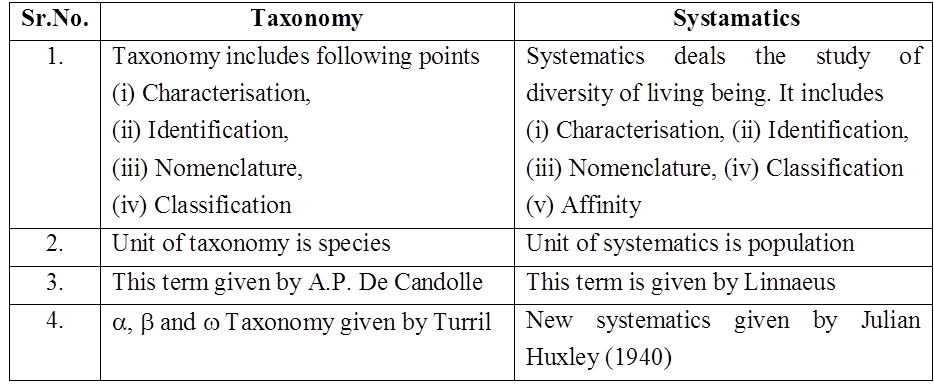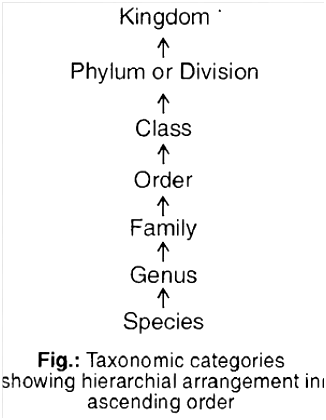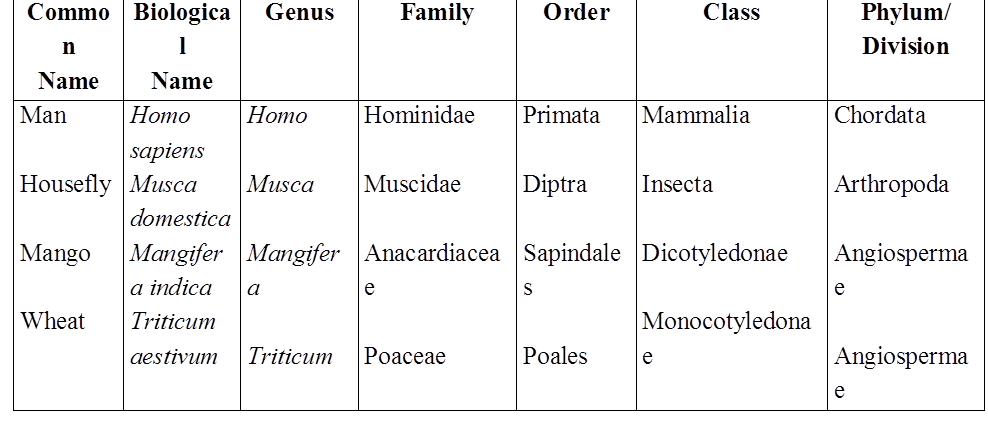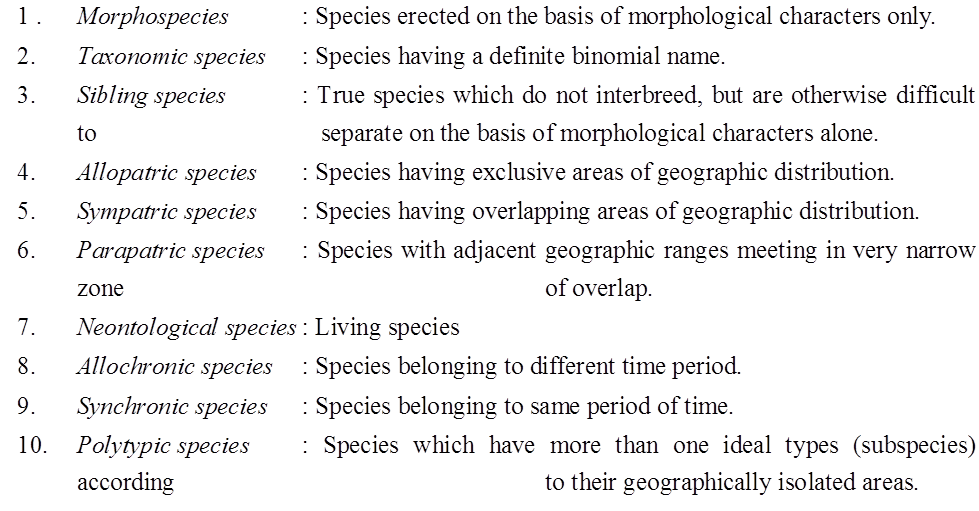- Books Name
- ACME SMART COACHING Biology Book
- Publication
- ACME SMART PUBLICATION
- Course
- CBSE Class 11
- Subject
- Biology
Taxonomy and Systematics
Taxonomy: The branch of science dealing with the study of principles and procedures of classification is called taxonomy. The term taxonomy was coined by A.P. de Candolle. Linnaeus is considered as Father of Taxonomy. Santapau is considered as Father of Indian Taxonomy. The fundamental elements of taxonomy are as follows :
- Characterisation and identification : It is the determination of the similarities of an organism with an already known organism, based upon specific characters.
- Nomenclature: It is the determination of correct name of an organism according to established universal rules.
- Classification: It is grouping of organisms into convenient categories on the basis of easily observable characters.
-
The classical taxonomy is based on observable morphological characters, however the modern taxonomy deals with several characters for the classification of organisms like
(a) External and internal structure alongwith the structure of cell.
(b) Development process.
(c) Ecological information of organisms
Systematics : The word "systematics" is derived from Latin word systema which means systematic arrangement of organisms. It was first used by Carolus Linnaeus. According to him, "systematics is the discipline of biology which deals with the kind and diversity of all organisms and the existing relationships amongst them."
Generally, the terms such as classification, systematics and taxonomy are used interchangeably but some taxonomists like Simpson (1961) relate them with a separate field. He defined systematics as
"The study of diversity of organisms and all their comparative and evolutionary relationships based on comparative anatomy, comparative ecology, comparative physiology and comparative biochemistry."
The main uses of systematics are as given below :
(i) It helps in providing knowledge of great diversity of animals and plants. It provides information regarding evolution which took place among plants and animals by knowing the distinction, relationship, habitat and habits. It thus, gives a vivid picture of entire organic diversity.
(ii) It helps in the identification of fossils which gives useful information about the phylogeny of organisms.
(iii) Newly discovered organisms can be identified through systematics.

TAXONOMIC CATEGORIES

- Classification is not a single step process. It involves hierarchy of steps in which each step represents a rank or category.
- The category is a part of overall taxonomic arrangement. All categories together make taxonomic hierarchy.
- Each category is also termed as a unit of classification. It represents a rank and is commonly called as taxon.
- The taxon must be recognisable and order should belong to a category.
- Taxonomic hierarchy is a series of different ranks placed in ascending or descending order.
- It was Linnaeus who for the first time introduced five categories in the taxonomic hierarchy, viz., class, order, genus, species and variety.
- Later on three more categories, viz., kingdom, division or phylum and family were added.
- Variety was Species discarded to make a hierarchy of seven obligate categories.
- Taxonomic categories kingdom -division (in plants) or phylum (in animals) -class -order -family -genus -species. (descending order)
- Higher the category, higher is the number of organisms in it. Higher the category, fewer will be the number of common characters and greater is the difficulty of determining the relationship to other taxa at the same level. Hence, the problem of classification becomes more complex.
- Taxonomic categories and hierarchy can be illustrated by an example. Insects represent a group of organisms sharing common features like three pairs of jointed legs.
- It means insects are recognisable concrete objects which can be classified, and thus were given a rank or category.
- Similarly, mammals represent animals with external ears, body hairs, mammary glands etc. Dog, mammals, animals are all taxa but of different categories.
- Taxon dog, mammals and animals represent categories like species, class and kingdom respectively.
Species:
- Term given by John Ray. It is lowest category of classification. It is a group of closely related individuals with similar morphological, anatomical, biochemical and cytological characters.
- It is a group of naturally interbreeding population with the ability to produce fertile offsprings.
- Individuals of a species share common gene pool.
- It is reproductively isolated, thus genetically closed system.
e.g, Pisum sativum – Pea
Mangifera indica – Mango
Solanum tuberosum – Potato
Panthera leo – Lion
Homo sapiens – Human being
In these, sativum, indica, tuberosum, leo, sapiens represent the specific epithet, while Pisum, Mangifera, Solanum, Panthera and Homo represent genus.
Genus:
- Genus is a group of related species. Species has more characters in common in comparison to species of other genera.
- e.g., Potato, (Solanum tuberosum), makoi (S. nigrum) and brinjal (S. melongena) are three different species belonging to same genus Solanum.
- Lion, leopard and tiger with several common features belong to the same genus Panthera.
Family:
It is a group of related genera with still less number of similarities as compared to genus and species. Families are characterised on the basis of both vegetative and reproductive features of plants.
- For example, four related genera Solanum, Petunia, Datura and Atropa belong to the family Solanaceae. Genus Panthera and Felis (cat) are put together in family Felidae.
Order:
- It is a group of related families which exhibit a few similar characters. The similar characters are less in number as compared to different genera included in a family.
- For example, plant families like Convolvulaceae and Solanaceae are included in order Polymoniales mainly based on floral characters.
- In animals, order carnivora includes families like Felidae (cat) and Canidae (dog).
Class:
- It is a group of related orders.
- For example , plants order like Sapindales (mango) and Polymoniales are included in Class -Dicotyledonae, Order -Volvocales (Volvox) and Conjugales (Spirogyra) are included in Class -Chlorophyceae (green algae).In animals, order Primata (man, monkey) and Carnivora (cat, dog) are included in class -Mammalia.
Phylum/Division :
- It is a group of related classes.
- The phylum Chordata of animals contains not only the class mammalia but also aves (birds), reptilia (reptiles) amphibia (amphibians) and osteichthyes (fishes).
- In case of plants, classes with few similar characters like dicots and monocots constitute division -Angiospermae.
- The category phylum is used in animalia while division is used in plantae.
Kingdom:
- It is highest category in hierarchy with related phylums or divisions.
Kingdom animalia includes all animals belonging to different phyla. Kingdom Plantae includes all plants of various divisions.

Concept of Species :
Biological concept of species (was given by Ernst Mayr) : Species is the fundamental unit of classification. A species is a group of organisms (i) which are closely related (structurally and functionally) sharing a common gene pool (ii) which can interbreed freely in nature and produce fertile offspring in a natural environment. This concept of species is based upon reproductive isolation and called biological concept.
Some important interspecific hybrids (exception of biological concept of species)
(i) Sterile Hybrid (under natural conditions)
Mule = Between male donkey and female horse (Mare)
Hinny = Between male horse (Stal'lion) and female donkey
(ii) Fertile Hybrid (under captive conditions)
Tigon = Between male tiger and female lion
Liger = Between male lion and female tiger
Types of Species :

TAXONOMICAL AIDS
- The laboratory and field studies are required for identification of various species and their placement in taxonomical hierarchy.
- The information thus gathered about the species, needs to be stored for future use.
- The taxonomical aids developed by biologists have established certain procedures and techniques to store and preserve the information as well as the specimens

 ACME SMART PUBLICATION
ACME SMART PUBLICATION
